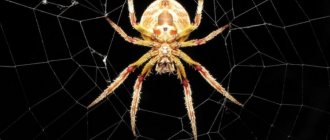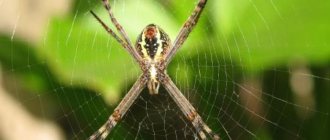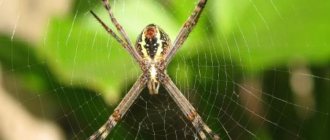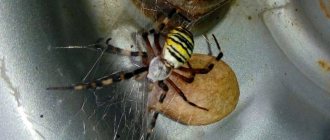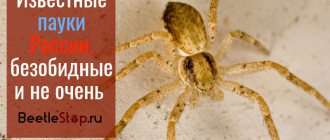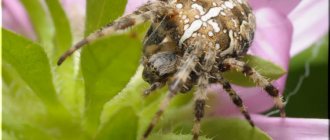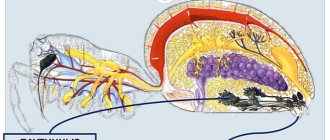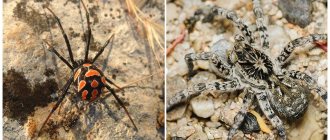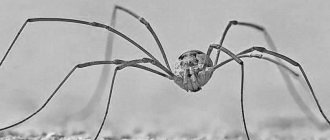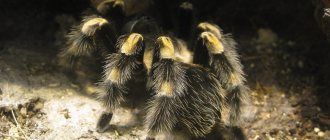Author: Bridge
25 May 2022 21:26
Community: Animals
Tags: drugs, spiders, experiments
25115
8
Zoologist NM Peters and pharmacologist Peter Witt began studying spiders in Germany in the late 1940s. In a series of classic experiments, Witt gives spiders various drugs. In order to inject drugs into spiders, they stuffed flies with them and slipped them into the spiders. After eating the potion, the spiders began to weave webs, the appearance of which interested scientists.
Scientists planned to test how arthropods weave their silk houses under the influence of drugs. As a result of the experiment, it turned out that intoxicated spiders do not stop weaving, but create strange webs. Several other scientists, including NASA researchers, have also studied the effects of drugs on spiders, hoping to find out how it affects the ability to spin webs.
Laboratory with spiders.
0
See all photos in the gallery
×
The marijuana-fed spiders produced some acceptable canvases, but were easily distracted. Under the influence of LSD, unusually smooth webs with precise geometric shapes were obtained. Caffeine had an extremely destructive effect on the spiders - the subjects were unable to create anything other than some random threads. The end result was a most deformed network, even worse than one made with chloral hydrate, which is used in sleeping pills. “Spiders are special, they are perfect for experimenting with drugs because we can see the results almost immediately,” said scientist Martin Croyels (leading arachnologist).
Why doesn't the spider stick to the web?
If the substance described is so sticky, then why doesn’t its creator himself stick to the creation?
One important fact has already been mentioned. Threads are produced in 2 categories at once - dry (not sticky) and viscous (sticky). The creator of the web moves precisely along the first ones. Just like his offspring.
And if we are talking about the construction of the network itself (during the process all the threads must be glued together), then everything is clear here too. The spider secretes glue on its special legs. He smears it on the section of thread he walked over. The spider remembers everything.
Moreover, a substance is also released that, during movement, reduces the adhesion of the adhesive type of legs to the thread. To prevent these special legs from sticking to one of them.
Thus, it is clear that the spider is a combination consisting of three types of secretion at once. Different pairs of legs work with the glands. Some processes destroy an object in order to make a hole (the spider drags the victim there). The processes presented are controlled by the nerve center.
Paper craft Spider on a cobweb
If your child is afraid of spiders, you can try to rid him of this phobia by showing him that these insects can even be funny. A simple craft “Spider on a Web” will help you do this, which is very easy to do with your own hands. To create parts, you should use the symmetrical cutting technique, following the detailed instructions below.
1. You don’t need any complicated template for cutting out the web. To begin, take a square piece of white paper. To get a more weightless canvas, use a thin napkin, but regular office paper will also work.
2. Start folding the prepared square, clearly aligning the sides. First make a rectangle.
3. Fold the rectangle again to form a square.
4. Next, align the opposite corners, bending the resulting triangle diagonally.
5. Fold the resulting triangle one or two more times. The thickness of the web depends on the number of folds. Use scissors to trim the edge to make it neat.
6. Use scissors to create cloves of equal width.
7. Unfold the folded square to straighten the web. The product can even be ironed with a warm iron to make it perfectly smooth.
8. To create a spider, you should also fold a small piece of dark paper in half, draw a template for one half of the insect and cut it out.
9. Straighten the web dweller.
10. Glue two white eyes to make the spider funny.
11. Glue the insect onto the web. The craft is ready.
Such a product will replace a snowflake if the task is to decorate a room for the New Year, or is suitable as an attribute for celebrating Halloween.
@Kaleidoscope Decor
Don't put them out on the street
Some species of spiders have evolved to live indoors and will not survive outdoors. Most spiders that live in homes were born and raised there and have never lived in the wild. In other words, not only are we now expected to love spiders and not kill them, but we are also expected to happily share our homes with them.
Colored yarn will become a cute decoration for a lampshade: update it yourself
Floral raincoats and fur bags: unusual trends for spring-summer 2021
Emphasis on the waist and convenient storage of things: the most fashionable models of belt bags 2021
They are harmless
The next argument in defense of spiders is that they are not aggressive. Spiders avoid people, and arachnologists (people who specifically study them) promise that you will never see most of the spiders that live in your home.
Taurus, Scorpio: 5 Zodiac Signs Who Love to Play Mind Games
Was there ever life on Mars: Perseverance thermal imagers are looking for life
There are only two days in April: when to sow tomatoes for seedlings to get a harvest
You'd like to believe them, unless you know about the Sydney funnel-web spider, which is known to attack people and has fangs so sharp they can cut through skin. But unless you live in Australia, you probably don't have to worry.
Chemicals. Overview and features of use
Modern acaricides cope very well with cobwebs on houseplants. There are two groups of funds from this class.
- Acaricides are specific, the action of which is directed exclusively against spider mites. Such drugs are characterized by a contact form of activity and differ in the degree of effectiveness relative to different phases of parasite development.
- Insectoacaricides work to destroy not only spider mites, but also against other pests of indoor plants.
Let's look at representatives of each group.
Specific acaricides
These drugs include the following: Borneo, Envidor, Apollo, Omite, Sunmite, Flumite. In addition to them, there are two more similar tools, which we will look at in more detail.
- "Floromite." Its active ingredient is biphenazate. This drug is active against all mobile stages of spider mite development, and 3 hours after the start of treatment, the parasite weakens and no longer harms the plant. Maximum effectiveness is evident during the first 4 days from the moment of use, the effect lasts for about 2-3 weeks.
- "Nissoran". This is a hormonal drug with enteric contact action, based on hexythiazox. Its acaricidal properties extend to the destruction of ticks belonging to various species, and has a detrimental effect on larvae, nymphs and eggs. During operation, the active substances inhibit the main processes on which the normal development of the parasite depends: molting, formation of chitinous cover, pupation and fledging.
Insectoacaricides
Insectoacaricides include the following drugs: “Aktellik”, “Fitoverm”, “Aktofit”, “Oberon”, “Dursban”, “Kleschevit”. In addition to them, two more means are known.
- "Vertimek". A broad-spectrum insecticide that very successfully protects indoor flowers from parasites. The basis of this drug is abamectin. During the processing process, the active substance penetrates the plant’s body and spreads throughout it very quickly. Pests that drink poisoned juice lose their ability to feed and soon die.
- "Akarin" ("Agravertine"). It is highly effective against all types of herbivorous mites and other parasites. It is based on a whole complex of natural highly specific neurotoxins, which, when entering the pest’s body, provoke the development of irreversible processes in its nervous system.
Interesting features of the haymaker spider
- If you catch a spider by the leg, it will easily come off and continue to perform convulsive movements for some time. This does not mean at all that the spider’s legs are not firmly attached to the body. The harvestman deliberately separates the limb, just as a lizard separates its tail. This anatomical feature helps him escape from enemies. When attacking, the predator first stumbles upon the spider's limbs, and then is distracted by the moving leg, which allows the spider itself to escape. Severed limbs are lost forever, which is why both in nature and in the house you can find individuals who have an unpaired number of legs.
- The web of the haymaker spider differs in shape from the web that other species of spiders weave. It does not have the traditional radial appearance. Their web is shapeless and looks like a random interweaving of threads. Such chaos is necessary to catch the victim. An insect, once in this labyrinth, tries to get out of it and gets even more stuck in the web. After the victim stops showing signs of life, the spider begins to entangle her even more and finally delivers a fatal bite. The spider can eat its prey right away, or it can put it off for later.
- When a spider senses a threat to its life, it begins to vibrate strongly, shaking its webs so that they are clearly visible and potential prey does not fall into them. If, nevertheless, an insect is caught in the web, which remains dangerous for the spider, it can gnaw through several threads so that the victim can free itself.
Where is it formed and where does it come from?
Spiders and their webs are a unique natural phenomenon in their own way. The weaving process is reminiscent of the production of cotton candy - a pre-mixed composition is pulled out of a narrow opening in the tank and hardens in air in the form of a thin thread.
The container is the animal’s abdomen, and the material is the secretion produced by its internal arachnoid glands.
In the lower part of the spider’s body (opistome) there are from 1 to 4 pairs of growths - arachnoid warts. In some species, these outgrowths are mobile and simultaneously serve as an organ of touch. This is the area where the spider produces its web.
Part of the surface of warts is dotted with small hairs - arachnoid tubes. Each of them is the exit duct of the internal gland and consists of two parts - thick (basal, internal) and thin (formative, terminal). The area with the tubes is called the arachnoid field.
Along with the tubes, chitinous cones, also located on the surface of the warts, participate in the production of the web. Larger glands open in them.
The release of the thread is controlled by the spider's central nervous system. Thickness, stickiness and even shade may vary.
To achieve this, various types of glands are involved in the weaving process, for example:
- tube-shaped - produce threads for the egg cocoon. Males do not have this type of gland;
- ampoule-shaped - produce dry thick threads for the base of the network;
- pear-shaped - strong thin fibers for attaching the web to the base;
- lobular - double silk fiber, the basis of the spiral threads of the fishing net;
- tree-like - they secrete glue to cover the base, which does not harden when in contact with air. With high magnification, droplets will be visible on the threads - the sticky secretion of the arborescent glands. It is on them that moisture concentrates during rain.
Each variety of spider has its own set of glands. Switching from one to the other takes about a minute. The cross spider weaves a web using 6 glands. Its arachnoid warts have from 480 to 560 tubes and about 20 cones.
Ten most common myths about spiders
Arachnophobia (fear of arachnids) is one of the most common human phobias. However, most people are afraid of spiders not because they are poisonous or dangerous, but only because they are smaller than other creatures living on our planet, similar to people and simply disgusting. This is probably why there are many myths about them that are passed down from generation to generation. We bring to your attention ten of the most common myths about spiders:
10. Absolutely all spiders weave webs.
You will be surprised, but only half of all known species of spiders use webs to catch prey - all the rest actively hunt, stalking their prey, as most animals do.
There is a type of spider that does not weave a web, but shoots it directly at its prey, or shoots it into the air, and then waits for the prey to fall into it. Representatives of another type of spider - Trapdoor spiders - construct a kind of hatch in which they hide until the prey is within reach. 9. Spiders can live in human hair
The appearance of this myth, popular in the 50s of the last century, is associated with the fashion for tall women's hairstyles with a bouffant, similar to a beehive.
These hairstyles were quite complex and expensive, so it was assumed that women rarely washed or combed their hair, making them ideal nests for spiders. 8. Spiders don't get caught in their webs.
In fact, they can, because they have no immunity to their own stickiness. They just move very carefully along their web so as not to get stuck. In addition, it is not sticky everywhere: some types of spiders, for example, weave webs in which only the circular threads are sticky, and along the ray threads they move unhindered. For a spider to get caught in its own web, it would have to land on more than one drop of glue, which is unlikely. 7. “Don't kill him! Let me better let him out into the street!”
Surely you have heard something like this at least once from a compassionate animal lover.
Don't be fooled by him. The fact is that house spiders (mostly harmless to humans) cannot survive outside - they are adapted to life indoors and will freeze to death outside. Therefore, by releasing them onto the street (even with good intentions), you absolutely doom them to certain death. 6. Spiders can lay their eggs under human skin
Let's dispel this myth too.
Firstly, spiders simply physiologically cannot do this: unlike some types of wasps that lay their eggs inside other animals, spiders simply have nothing to introduce them with. Secondly, spiders care very seriously about their offspring, so they never lay eggs where there is even the slightest threat. They do this in secluded, hidden, protected places. 5. There is always at least one spider within a radius of almost one meter from you
The birth of this myth is associated with the name of archaeologist Norman Platnik.
In one of his articles in 1995, he wrote: “...wherever you are reading this book, there is probably a spider no more than a few meters away from you...”. This statement was perceived as a fact, although the author was simply speculating. Time passed, “a few meters” was replaced by one meter, the word “probably” disappeared altogether, and by 2001 these lines were already quoted as a fact. 4. Female Black Widows (Latrodectus mactans) eat their males after mating.
This is not so much a myth as it is rather misinterpreted information.
The females of some species of spiders of this genus actually eat the males, but this happens much less frequently than many people think. Of all the existing species of spiders of the Black Widow genus, only representatives of some species do this, and then only when hungry (and this, you see, is not uncommon in the animal world). The size of the males of this genus is less than one-fourth the size of the female’s body, and during mating the males must be very close to her mouth, which in turn makes it very difficult to escape (although some still manage to somehow manage to escape). In a word, the rumor about this is greatly exaggerated, and only a few Black Widows succeed in eating males. 3. Over the course of a year, a person accidentally swallows a number of spiders
This myth began because one woman (Lisa Holst) decided to prove that people can believe almost anything they read on the Internet.
Having created a newsletter with false facts (taken from the book “Facts and Fictions about Insects”), she sent it to email addresses and, in principle, proved her point, since this myth is one of the most common. 2. Harvesting spiders have the most potent venom.
You may have heard this myth too: harvest spiders supposedly have the most powerful venom, but they do not have fangs with which to inject it.
We hasten to say right away that “haymaking spiders” do not exist as such - there are a large number of different insects that are meant by this name. Moreover, some of them (such as long-legged mosquitoes or haymakers) are not even spiders, while others have no poison at all. In fact, when talking about hay spiders, people most often mean long-legged spiders (Pholcidae) - they have poison, but it is completely harmless to humans. 1. Everything you know about the camel spider
This myth was circulating on the Internet several years ago. Allegedly, the length of these creatures (they have several scientific names - phalanges, salpugs) can reach 30 cm, they can run at a speed of 40 km/h with screaming sounds, hide on the bellies of camels and are terribly poisonous. There was even a rumor that one such salpuga killed a soldier who served in Iraq. In fact, salpugs (phalanxes), of course, belong to the class of arachnids, but they are not spiders. They rarely reach sizes larger than 15 cm; the fastest representatives of the phalanx squad run at a speed of no more than 16 km/h and are not capable of everything that is said in the myth about camel spiders. But meeting him, of course, is unlikely to make you happy. ...and yes, just in case, look around and see if there is any representative of the arachnid class hanging over you
Composition of the web
The basis of the web (2/3 of its composition) is the water-insoluble protein fibroin (fibrillar protein). This is a substance that gives spider webs increased strength. It consists of a complex of simple proteins (albumin), d-alanine (amino acid), glutamic and aminoacetic acids.
The stickiness of the web is provided by sericin (a substance of protein origin, silk glue). The chemical composition of the web also includes potassium nitrate and hydrogen phosphate, which provide protection against bacteria and fungi.
Depending on the type of glands used, the spider produces about 7 types of fibers of different chemical compositions, from which it weaves the structural parts of the web.
The structure of the thread is heterogeneous. It is composed of rigid protein crystals firmly connected by elastic ligaments. In terms of its chemical composition and properties, the web is similar to silkworm silk, but spider silk is stronger.
The thread retains tensile strength and does not twist even with prolonged rotation. The last property is called “hinge”. Sunlight, hot and dry air weaken the strength of the thread.
